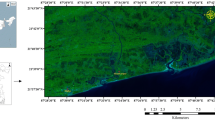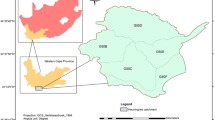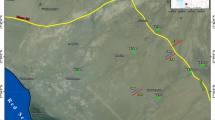Abstract
Integrated hydrogeochemical and geophysical methods were used to study the salinity of groundwater aquifers along the coastal area of north Kelantan. For the hydrogeochemical investigation, analysis of major ion contents of the groundwater was conducted, and other chemical parameters such as pH and total dissolved solids were also determined. For the geophysical study, both geoelectrical resistivity soundings and reflection seismic surveys were conducted to determine the characteristics of the subsurface and groundwater contained within the aquifers. The pH values range from 6.2 to 6.8, indicating that the groundwater in the study area is slightly acidic. Low content of chloride suggests that the groundwater in the first aquifer is fresh, with an average concentration of about 15.8 mg/l and high geoelectrical resistivity (>45 ohm m). On the other hand, the groundwater in the second aquifer is brackish, with chloride concentration ranging from 500 mg/l to 3,600 mg/l and very low geoelectrical resistivity (<45 ohm m) as well as high concentration of total dissolved solids (>1,000 mg/l). The groundwater in the third aquifer is fresh, with chloride concentrations generally ranging from 2 mg/l to 210 mg/l and geoelectrical resistivity of greater than 45 ohm m. Fresh and saltwater interface in the first aquifer is generally located directly in the area of the coast, but, for the second aquifer, both hydrogeochemical and geoelectrical resistivity results indicate that the fresh water and saltwater interface is located as far as 6 km from the beach. The considerable chloride ion content initially suggests that the salinity of the groundwater in the second aquifer is probably caused by the intrusion of seawater. However, continuous monitoring of the chloride content of the second aquifer indicated no significant changes with time, from which it can be inferred that the salinity of the groundwater is not affected by seasonal seawater intrusion. Schoeller diagrams illustrate that sulphate concentrations of the groundwater of the second aquifer are relatively low compared to those of the recent seawater. Therefore, this result suggests that the brackish water in the second aquifer is probably from ancient seawater that was trapped within the sediments for a long period of time, rather than due to direct seawater intrusion.






Similar content being viewed by others
References
Barker RD (1990) Improving the quality of resistivity sounding data in landfill studies. In: Ward SH (ed) Geotechnical and Environmental Geophysics, vol 2: Environmental and groundwater applications. Society of Exploration Geophysicists, pp 245–252
Banton O, Seguin MK, Cimon MA (1997) Mapping field-scale physical properties of soil with electrical resistivity. Soil Sci Soc Am J 61:1010–1017
Haryono A (1997) Penggunaan Kaedah geofizik dan geokimia untuk mengesan penerobosan air masin ke dalam akuifer pantai, di utara Kelantan. PhD thesis, National University of Malaysia, Malaysia
Haryono A, Abdul RS, Abdul GR, Nasiman S (1995) Penggunaan kaedah-kaedah hidrogeokimia dan kerintangan geoelektrik untuk mengesan kemasinan air tanah pada akuifer kedua di pantai utara Kelantan (abstract). Annual Geological Conference, pp 53–55
Ismail M (1992) Status pengawasan air tanah di Delta Sungai Kelantan, Laporan Persidangan Geologi ke 23, Penyiasatan Kajibumi Malaysia, no. 4
Mazac O, Cislerova M, Kelly WE, Landa I, Venhodova D (1990) Determination of hydraulic conductivities by surface geoelectrical methods. In: Ward SH (ed) Geotechnical and Environmental Geophysics, vol II: Environmental and groundwater applications. Society of Exploration Geophysicists, Tulsa, USA, pp 125–131
Miller RD, Doll WE, Merey C, Black WE (1994) Application of shallow high-resolution seismic reflection to environmental problems. Environ Geosci 1:32–39
Noor IM (1979) Prefeasibility study of potential groundwater development in Kelantan, Malaysia. PhD thesis, University of Birmingham, UK
Pfeifer D, Chong FS (1974) Groundwater exploration in Kota Bharu. Report no. 21, Geological Survey of Malaysia, p 139
Pfeifer D, Tiedemann O (1986) Hydrogeological studies and the development of groundwater in the Kelantan Coastal plain, Malaysia. Vol 24, Natural Resources and Development, Institute for Scientific Cooperation, Tubingen, Germany pp 72–82
Rhoades JD, Ingvalson RD (1971) Determining salinity in field soils with soil resistance measurements. Soil Sci Soc Am Proc 35:54–60
Rhoades JD, Shouse PG, Alves WJ, Manteghi NA, Lesch SM (1990) Determining soil salinity from soil conductivity using different models and estimates. Soil Sci Soc Am J 54:46–54
Umar BH, Haryono, Abdul RS, Abdul GR, Che AA (1997) High resolution multichannel seismic profiling: a case study at Pak Pura, Bachok, Kelantan. Warta Geol 23:231–237
Verma RK, Bandyopadhyay TK (1983) Use of the resistivity method in geological mapping—case histories from Raniganj coal field, India. Geophys Prospect 31:490–507
Acknowledgements
The financial support through the Universiti Kebangsaan Malaysia (National University of Malaysia) research grants no. 17/94 is gratefully acknowledged. The authors wish to record their appreciation to the Geological Survey Department of Malaysia for use of their hydrogeochemical data and assistance in collection of water samples from their monitoring wells. Special thanks are due to the field crew and clerical staff of the Department of Geology, Universiti Kebangsaan Malaysia, for assistance during fieldwork and in the preparation of this paper.
Author information
Authors and Affiliations
Corresponding author
Rights and permissions
About this article
Cite this article
Samsudin, A.R., Haryono, A., Hamzah, U. et al. Salinity mapping of coastal groundwater aquifers using hydrogeochemical and geophysical methods: a case study from north Kelantan, Malaysia. Environ Geol 55, 1737–1743 (2008). https://doi.org/10.1007/s00254-007-1124-9
Received:
Accepted:
Published:
Issue Date:
DOI: https://doi.org/10.1007/s00254-007-1124-9




